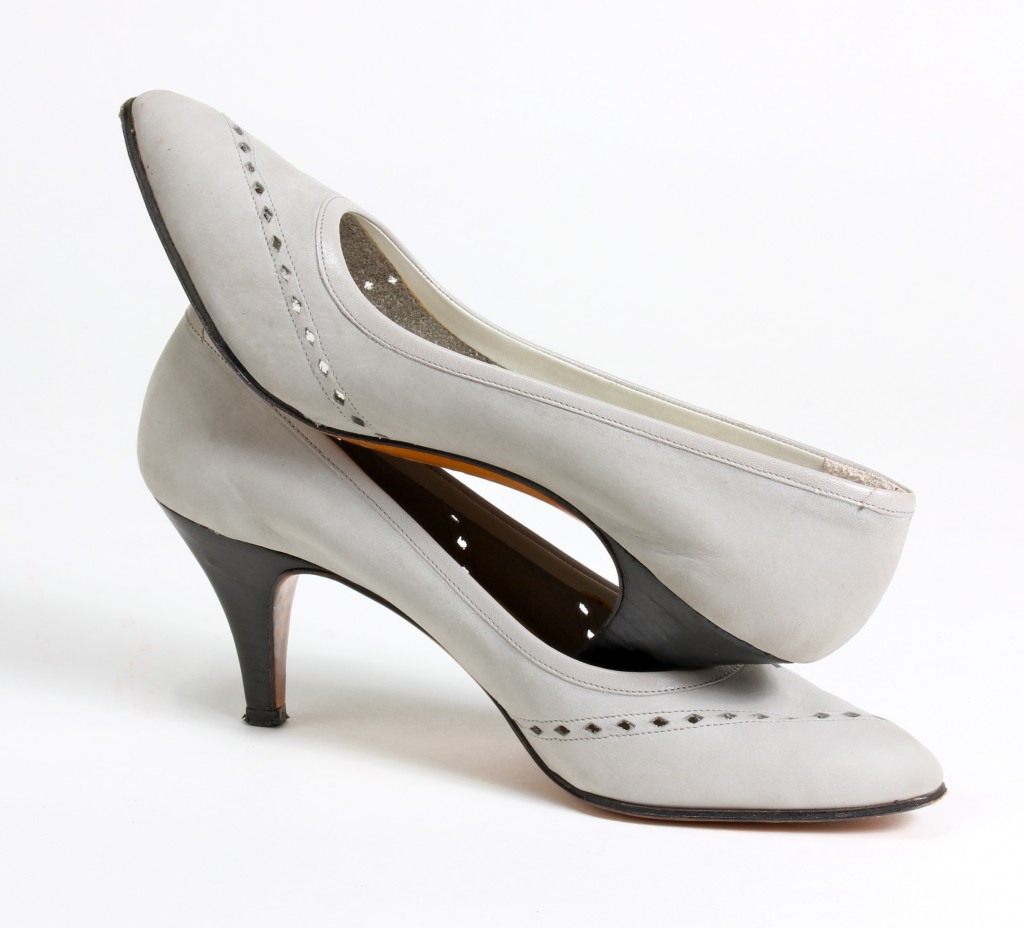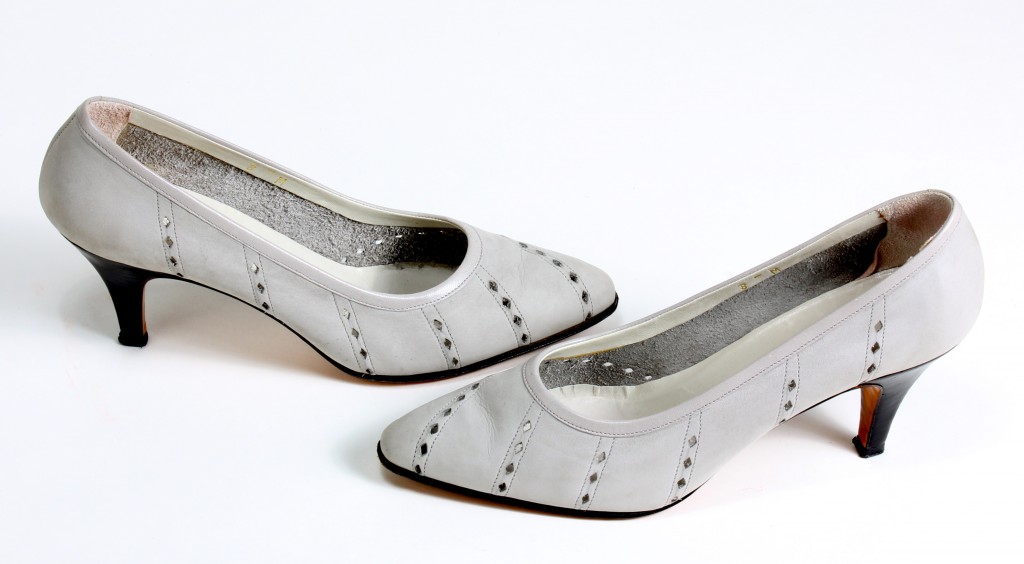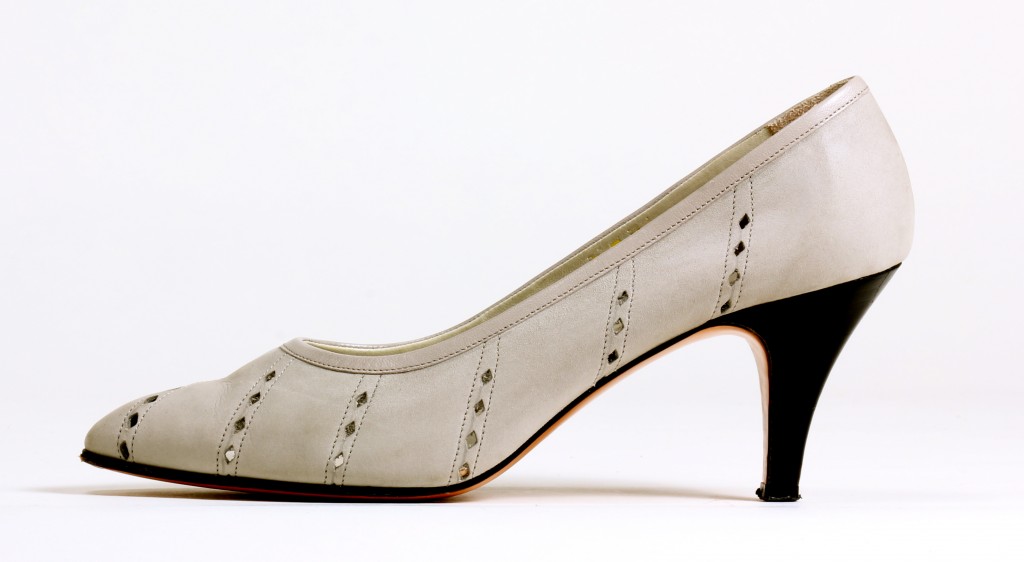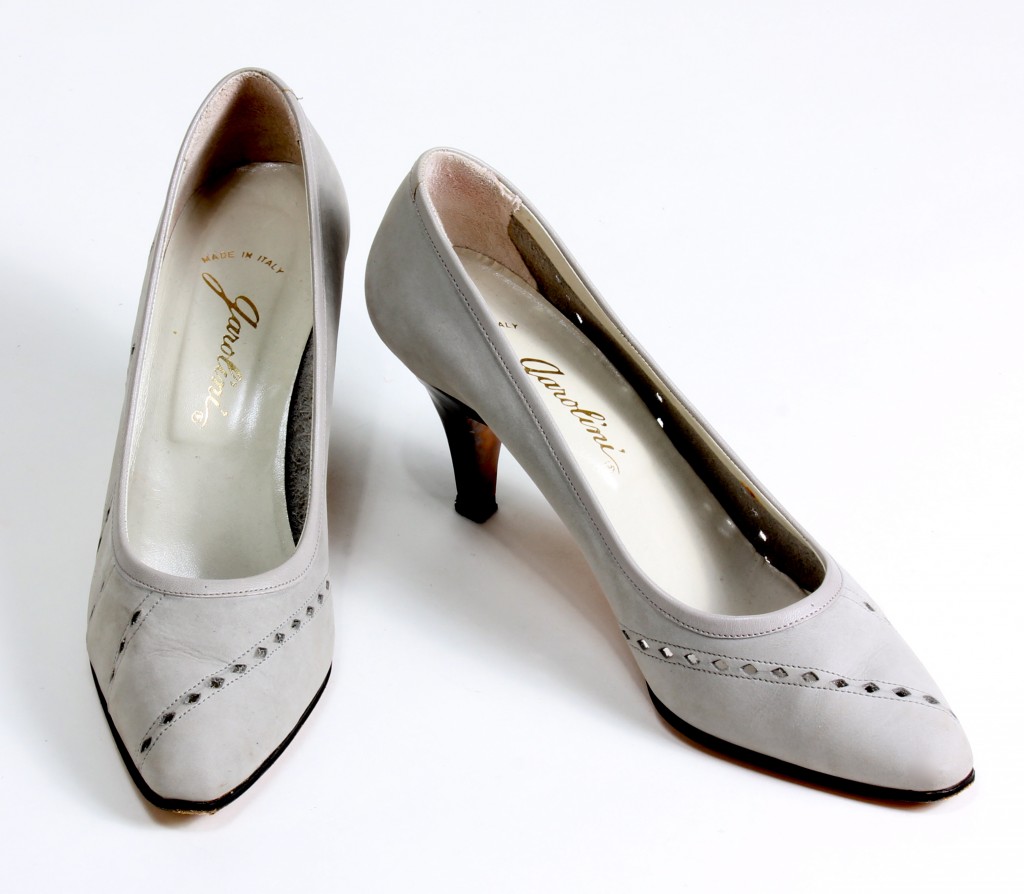
The Poached Moose Hide Pumps
Clients could get shoes custom made to order in the 1970’s from the Garolini workshops in Italy. This pair of soft gray moose hide suede pumps is one such example. My grandfather had four pairs of them designed and made for my grandmother, my mother, and my two aunts. There is an interesting story behind these shoes.
Grandpa was a sheep and cattle rancher in Idaho. His ranch was called The Eldorado Land and Livestock Company. It was a large operation. He raised organic sheep and cattle and farmed many crops including famous Idaho potatoes, sugar beets, raspberries, wheat, corn and alfalfa. His center of operations was a large ranch in southern Idaho near a small town named Melba after a family cousin. His operation was huge and he owned and operated several adjacent ranches.
Every June the family took their livestock to beautiful Bear Valley in the northern part of the state of Idaho to the summer grazing lands. Bear Valley is a National Sate Park run by the Federal Bureau of Land Management. My grandfather was one of five ranchers who had a 99 year family lease with grazing rights on this Federal Land. He had built a large summer house ~ which was a giant log cabin lodge ~ for his family to stay in and supervise the livestock operation during the summers. He employed Basque sheep herders who were also master leather workers on his ranches. He was a fan of fine leather goods. The Basque tanned hides and made many beautiful articles – saddles, bridles, harnesses, chaps, leather pack bags and feed bags, luggage, purses, and boots and shoes. One man made amazing soft and tough light gray moose hide moccasins for everyone in the family who all wore them as house slippers. It was because of these moccasins that my grandfather eventually decided moose hide would be a suitable material for ladies’ luxury shoes.

Grandpa decided that moose hide might be a good material for ladies' luxury shoes!
As soon as school was out my brother and I were sent from Portland, OR ~ where we lived with out parents during the school year ~ to summer on the ranches in Idaho. After about two weeks “down below” as my grandmother called it, on the main Southern Idaho ranch, where it was very hot and infested with rattle snakes on the Snake River, we would be taken North up to the Mountains to Bear Valley, where it was much cooler, to assist with the summer livestock drive. We spent about 8 weeks there, in the most beautiful pristine and isolated alpine meadows and forests you can possibly imagine. We lived in the “cabin” which was a beautiful two-story four bedroom hand built log house. There was no electricity and there were no people for miles. We had fresh clear water piped into the house from the icy cold mountain stream, a wood stove, kerosene lamps, several fireplaces, and a treadle sewing machine. In my opinion it was absolutely luxurious. We had all necessities and many luxuries and it was clean and exquisitely beautiful. We lived at the top of an Alpine meadow full of colorful wildflowers and blue butterflies. Wild strawberries and huckleberries grew profusely. There were many kinds of edible flowers, roots and berries one could gather and eat in salads or use as accent dishes on their own. My grandfather taught me to identify and use them. We caught fresh natural trout and white fish in the stream and ate them daily. And we made bread and pancakes from sour dough started that my grandfather’s mother had brought with her when he emigrated to the United States from Denmark as a seven year old boy.
The big log house was built on the edge of a meadow near a fir woods. Just inside the cover of the woods, where you could see it at a comfortably long distance from the kitchen window, my grandfather had set up a salt lick to attract deer so we could observe them. As soon as they realized we were safe they came every morning and we sat at the kitchen table, sipping hot chocolate, and quietly observing them. There were usually a couple of small spotted fawns as well as the adults. It was peaceful and beautiful.
We had horses and our grandfather would take us out on two day pack trips to explore the wilderness area. It was very remote. He and his herd men had a lot of work and responsibility, which we, as grades school aged children did not, but, we were required to work at anything suitable they assigned us to do. In my case it was helping with cooking and caring for the herd dogs which I really enjoyed. When time allowed and opportunities presented themselves, he would take us to do wonderful things like fishing or huckleberry picking, or to observe a herd of about 200 wild moose grazing in a remote mountain meadow. We would hide quietly in the trees and watch them for several hours. It was a magnificent experience. I remember tall ethereal and lacey purple fire weed flowers blooming in the lush meadow grasses. Small blue alpine butterflies were plentiful.
I thought this must be one of the most beautiful places in the world and looked forward to going there every summer. The area was not open to the public. You could only enter it with permits from the Forestry Department. It was completely closed to campers and tourists. As young children we knew we were very privileged to be able to spend time there. The area was remote so there were certain dangers. There was no electricity, there were no phones or telegraphs. We were completely isolated and dependent on the adults in out family who were experienced and knew the ways of the woods and the wildlife. The uniqueness of our situation was impressed upon us. We knew we were lucky. We were in the unique position of spending out school year in a city with cultural and educational advantages, and out summers in the country on a working farm and in the mountain wilderness. We had the best of both possible worlds.
Personally, in Bear Valley, at that time of my life, I felt like I was in heaven. In contrast, my mother and my aunts hated the place. It must be remembered that the adult women were responsible for taking care of small children and feeding hard working men without modern conveniences like washing machines and stoves. Everything had to be done by scratch. Clothes, and cloth diapers, had to be washed by hand with washboards in tubs in the sink using water boiled on the wooden stove. All the cooking had to be done on the wood stove. My mother was a professional nurse and if anyone got sick or injured she was responsible for sewing them up or taking care of emergencies. Things did happen. My grandfather had been a wagon train scout in his early teens in the the late 1800’s before homesteading in Idaho and building up his livestock and ranching business. Now that I am an adult women I can completely understand my mother’s feelings. She had to go there for a couple of months each summer to help with the family business and she fulfilled her obligations, but she preferred her nice house in the city with all her modern comforts and conveniences and access to her friends. She missed her telephone, her phonograph and records, the movies, cocktails and her clothes. And she said, more than once, that she missed wearing nice shoes while she was stuck up in the mountains!

You couldn't wear pretty feminine dress pumps like these while you were up in the mountains!
Bear Valley was a Designated Wildlife Preserve. Thus hunting was illegal. My grandfather was very much involved with the Bureau of Land Management and the National Forest Service in conservation efforts. He went to Washington DC as a consultant for the National Park Service and the Bureau of Land Management. National and state level forestry service and conservation people and organizations consulted with him regularly. Interesting people and top level officials were always coming by to meet with him. He was well known for his professionalism and commitment to the cause. He was 100% pro wildlife. He had unique hands on personal experience in all aspects of the wilderness. He was an expert.
Naturally, if someone violated any of the wildlife in the area, or the land, my Grandfather was enraged and flew into immediate action. The summer I was eight a poacher somehow entered the property and shot and killed a moose, then ~ probably afraid ~ left the carcass abandoned in a mountain meadow. My grandfather found it when he was riding out to check on his herds. It was a fresh kill. He was incensed. He and his herders brought the dead moose back to the to the herder’s campsite in the meadow near the log house. They searched for the poacher but never found him. They soon filed reports with the Idaho Forestry Department looking for the vandal. Wanted posters were put up everywhere in the small towns and forestry posts leading into the mountains trying to search him out, but he was never apprehended. Legally my grandfather and his men they were allowed to take possession of the carcass. They were determined to use the entire thing. I was impressed by how huge it was. They expertly skinned and butchered it, processed the meat and tanned the hide. That winter we ate a lot of moose steaks and moose burgers. Moose is very tough and has a strong game flavor. My grandfather was angry that a huge beautiful moose had been shot, but seemed determined to use every bit of it. Being who he was, there was no way he would allow an ounce of any part of it to go to waste.
My mother and my aunts were not delighted that they had to help process all this moose meat, nor that they were going to have to figure out creative ways to prepare and use it. There were hundreds and hundreds of pound of it! They correctly visioned that they were going to have to coax their children to eat it all through the next winter in order to please their father. And they did. They would have preferred to go to Safeway once a week and buy steaks wrapped up in neat see through modern grocery store display packages. Instead they had meat lockers full of organic sides of beef, entire pigs, slabs of bacon, large cuts of lamb, white butcher paper wrapped chuck or pot roasts and two pound packages of tough moose and bear burger that they had to coerce their children into eating.
The Basque sheep herders, on the other hand, were delighted to have the large and luxurious moose hide to work with and went right to work to properly process it. Moose hide is special. It is very soft when properly cured. Also very strong and has a lovely soft, almost powdery, dove gray color. And apparently, it is waterproof, or ended up being so when they got through working on it.
At the end of the summer we were sent home to Portland on the train (from the Boise, Idaho train station) with metal footlockers packed full of frozen organic beef and lamb tucked under our feet in the coach section as we rode home just in time to start school in the fall. Our father was a college professor in Portland and our mother was a nurse. My rancher grandfather was sure that they would never be able to get us proper meat or enough of it to get through the winter with proper nutrition so he sent us home with enough to fill two meat lockers at the end of every summer. This year we had a third foot locker full of ground moose burgers and moose steaks. All this meat was frozen rock solid when we left Idaho. The train ride was 16 hours long. The meat was expertly packed and still stone hard when we got home to Portland. My father would pick us, and the hundreds of pounds of meat ,up at the Multnomah County Train Station in downtown Portland and swing by Peterson’s Meat Market where the family kept a sub zero frozen meat locker on the way home. The first stop was always to drop off the meat. I had to walk to the meat market a couple of times a week, go into the freezing locker, and get out the packages of frozen meat for the weeks meals and carry it home. I was responsible for picking up and putting the right cuts of meat out to thaw on a schedule coordinated with my mother so that it would be ready to prepare meals according to her menu plans when she was ready to cook it. She was an ardent practitioner of Juliet Child’s French Cooking. Her best friend was Adelle Davis, the health food maven.
Thanks to my grandfather’s ranching and farming expertise and my grandmother’s and mother’s great cooking we had fantastic food and I grew up learning to cook very well from scratch. Our lives were all about raising, preparing and eating great food!
What on earth, you must be wondering, does any of this have to do with the pair of Garolini shoes pictured at the beginning of this post?

Well, lots actually!
My mother and her two sisters were born and raised on the Ranch of the Eldorado Land and Livestock Company in Southern Idaho. Her father was an outdoors man who became a very successful and wealthy rancher. He wanted to provide his wive and three daughters with all good things: educations, travel and exposure to society and the arts, fashion and culture. He sent them to college. And he sent them to live for extended periods with our relatives in Texas who worked for Nieman Marcus as top fashion models and designer clothing buyers in Europe. He expected his daughters to help out now and then in the family ranching business ~ in ways like going to Bear Valley in the summer as described above. They dutifully did as he requested. Mostly out of respect for his desires and to humor him. You had to do things his way for him to be happy with your efforts.
Every two or three years Grandpa would take his wife and three daughters on a really grand vacation as a reward for how well he was doing in his ranching business. He never invited or included their husbands or children ~ his grandchildren (that would have been me, so I missed out!) This was Grandpa’s way of bonding with his immediate family and sharing his success with them. They traveled to Egypt, China, Japan, South America, Hawaii, Brazil, Mexico, Africa, Italy, Scandinavia, Australia, Greenland, England, Scotland, France, Spain and eventually Italy. He arranged to study agricultural practices or wine making, or diamond mining, or some other practice or methods related to his own businesses on each trip so that he could write off his travel expenses. He expected his daughters to research every place and thing they would visit, and develop detailed itineraries before they left. They did so dutifully. And it was well worth it for their spectacular vacations and travel experiences.
On their travels they stayed in the world’s fanciest resorts and best hotels. Grandpa played the role of a Grand Old School American Businessman while his wife and three daughters thoroughly enjoyed themselves touring castles and museums, dining in fine restaurants and shopping. A grand time was had by all. Each trip lasted three of four weeks after which the girls returned home decked out in all manner of ethnic or European designer finery, furs, African diamonds, Scandinavian silver, fine Brazilian cowboy boots, etc. and, finally, after one spectacular trip, the finest in Italian leather goods and shoes!
Grandpa had lasts of his feet made in Argentina and ordered fancy custom made cowboy boots of exotic leathers made every year. He had rows and rows of them. He had cowboy hats made in Panama, saddles and tack in Spain, tailored clothing in London, a huge opal ring in Australia, leather luggage in Mexico, etc. He had fine cigars sent from Honduras. He played the guitar and someone somewhere had made him a beautiful custom instrument. He loved to reward himself with world travel and he loved to bring back wonderful luxuries from his sojourns.
When in Italy, in 1970, Grandpa and his wife and daughters had visited the Garolini Shoe Factory, and, as was his want, he had found out that one could get personal lasts made and have shoes custom made to fit their own feet to their own design specifications. The entire family had lasts made of their feet. When Grandpa got home he sent enough of the poached Bear Valley moose hide to the Garolini factory to make four pairs of ladies shoes. He asked them to make a pair of moose hide pumps for his wife and each of his three daughters as Christmas presents. Thus it was that Garolini designed and made four custom pairs of the soft gray moose hide pumps pictured above ~ one pair for my grandmother, and one pair each for my mother, and my two aunts.
The moose hide shoes are really lovely and feminine in person. They are a subtle soft dove gray color and velvety soft in texture ~ taking full advantage of the natural coloring and textural characteristics of the moose hide. The inside is the unlined raw suede wrong side of the hide and is very soft and comfortable on your foot. The shoes feature a punctured design for decoration and ventilation. My grandfather requested this characteristic in the design as it gets very hot in the summers in Southern Idaho and he thought it would be good for his wife and three daughters’ feet. The leather soles are edged in a fine black line and the tasteful 3 inch high heels are made with stacked leather soles also colored black to accent the gray moose hide uppers. The throat of the shoe is finished off with a 3/8″ piping of smooth gray kidskin dyed to match the moose hide exactly but of a smoother shinier texture. The insole is made in light gray leather and signed Garolini in silver script, made in Italy.

The Family Heirloom Moose Hide Shoes ~ Christmas 1970
This was a limited edition of four pairs of these shoes made to order for the women in the Rex Sylvainius Jensen Family. Three pairs were worn a great deal and I do not know their whereabouts. They have probably been discarded along the way. My mother only wore hers a few times and kept them very carefully. That is the pair I have. And I am fortunate that it fits me! As I inherited her feet! She thought these shoes were really special and wore them in the house on the carpets when people would come over for dinner. They were definitely conversation pieces!
My grandparents especially liked having things custom made as gifts for family members from materials harvested, produced. or raised on their ranches. For example, they had their sheep shorn, sent the raw wool to the Pendelton Woolen Mills in Pendelton, Oregon to be washed, carded and carefully spun into wool for custom made, dyed and personalized blankets. It was nice, for instance, as a little girl, to get an apricot colored blanket at Christmas made from Bessie’s wool with my name embroidered on it in a flowing green chain stitch.
These old fashioned refined personal gestures seemed so thoughtful!
Photographs by Fredric Lehrman.
Shoes from the Lady Violette Shoe Collection.
























